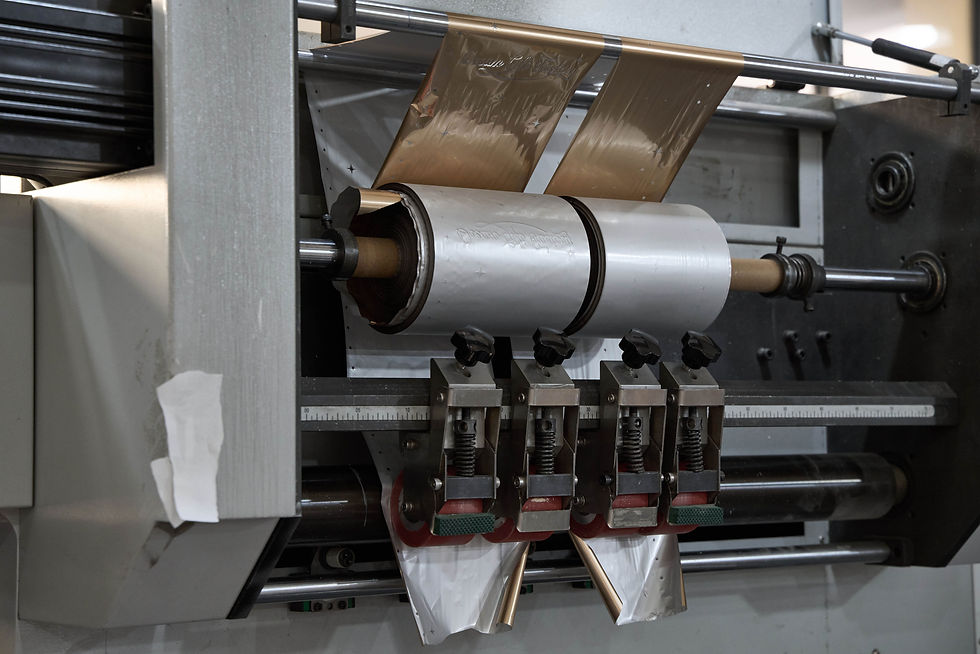Why Foil Stamping Can Make Your Notebook More Attractive?
- Lion Paper Team

- Jun 11
- 3 min read
Quick Content Reach:
What Is Foil Stamping?
Foil stamping is a finishing process where a metallic or pigment foil is pressed onto the notebook surface using heat and pressure. Common foils include gold, silver, rose gold, holographic, matte black, and eco-friendly degradable types.

The Science Behind the Shine: Why It Works
According to a study by Georgia Tech and FSEA, foil-stamped packaging increased perceived quality by 22%–30%. High reflectivity catches the eye within milliseconds, making your product stand out in both physical stores and digital shelves.
Higher Willingness to Pay: Real Commercial Value
63% of gift stationery buyers say they would pay at least 10% more for a foil-stamped notebook. At Lion Paper, one of our U.S. retail clients increased sales by 18% after adding rose gold foil to its planner line—without changing product specs.
Durability You Can Count On
Foil stamping is not only beautiful but long-lasting. Thanks to a resin-protected foil layer, the metallic shine resists scratches and wear for over 5 years under normal use.

Eco-Friendly Doesn’t Mean Dull
A 2020 FSEA white paper confirmed that foil-decorated paper poses no recycling issues during standard repulping. At Lion Paper, we pair foil stamping with FSC-certified papers to deliver eco-conscious elegance.
Design Possibilities: Foil Is Versatile
From classic gold logos to edge gilding, foil stamping can be applied to linen, PU leather, soft-touch lamination, and even edge foils. Common finishes include:
Flat foil
Foil + emboss
Edge gilding
Holographic foil

Estimated Cost vs. Return on Investment (ROI)
Foil stamping adds only $0.06–$0.12 per unit at MOQ 1,000. In small batch runs, our Korea factory offers cold-foil sampling in 3 days. For the marginal cost, it delivers significant perceived value
How Lion Paper Ensures Quality in Every Foil Stamped Notebook
We use visual alignment equipment, precision foil stamping machines, and 10+ QA staff with video monitoring. All processes comply with ISO9001 and CPSIA standards, with full transparency for clients.

Foil Stamping Tips for Buyers
Conclusion
Foil stamping is more than a decoration—it’s a signal of quality, care, and craftsmanship. With the right foil, your notebooks don’t just sit on the shelf—they shine.
FAQs:
Q1: What is foil stamping in notebook production?
A: Foil stamping is a finishing process where a thin metallic or pigmented foil is pressed onto the notebook surface using heat and pressure. It creates a reflective, luxurious effect that enhances brand image and product appeal.
Q2: Is foil stamping environmentally friendly?
A: Yes. According to the Foil & Specialty Effects Association (FSEA), foil stamping does not hinder paper recycling when done on standard paper stock. Lion Paper also uses FSC-certified papers to ensure eco-compliance.
Q3: How long does foil stamping last on a notebook?
A: Properly applied foil stamping can remain vibrant for over 5 years under normal usage, thanks to abrasion-resistant resin layers in modern foils.
Q4: What are the most popular foil colors for notebooks?
A: Gold, silver, rose gold, holographic, and matte black are the most requested foil colors for planners and journals, especially in premium collections.
Q5: Can foil stamping be applied to different notebook materials?
A: Yes. Foil stamping works on coated/uncoated boards, linen-texture paper, PU leather, soft-touch lamination, and even edge gilding on inner pages.
Q6: What is the difference between foil stamping and metallic ink?
A: Foil stamping uses a heat-bonded metallic film that sits on the surface and remains vibrant. Metallic inks are mixed into printing ink and often fade or dull after drying.
Are you looking for a reliable manufacturer? Reach out to Lion Paper for a free quote and consultation. Let’s collaborate on creating custom writing paper products that will set your brand apart from the competition.







Comments